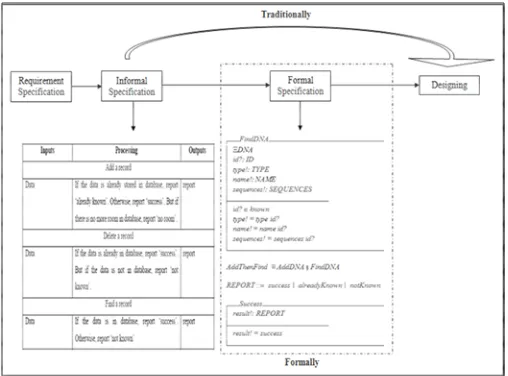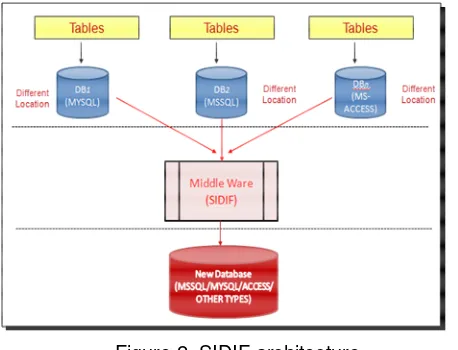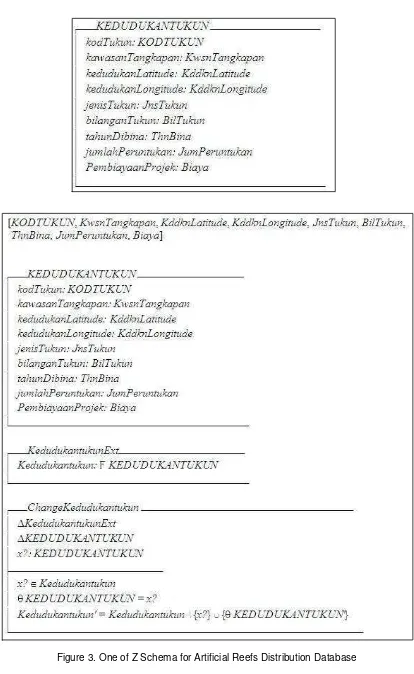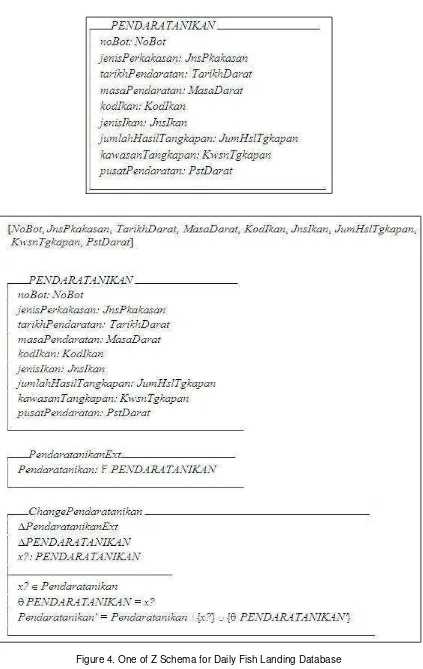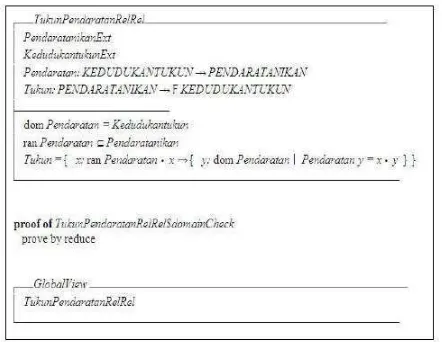ISSN: 1693-6930
accredited by DGHE (DIKTI), Decree No: 51/Dikti/Kep/2010 81
Formal Specification for Spatial Information Databases
Integration Framework (SIDIF)
Mustafa Man*1, Julaily Aida Jusuh2, Mohd Shafry Mohd Rahim3, Mohammad Zaidi Zakaria4 1
Dept. of Computer Science, Fac. of Science and Technology, Universiti Malaysia Terengganu 21030 Kuala Terengganu, Terengganu, Malaysia, Tel: 09-6683307 fax: 609-6694660 2
Dept. of Computer Science, Fac. of Computer Science and Information Technology, Sultan Zainal Abidin 21030 Kuala Terengganu, Terengganu, Malaysia
3
Dept. of Computer Graphics & Multimedia, FSKSM, Universiti Teknologi Malaysia 81310 UTM Skudai, Johor Bahru, Malaysia
4
Dept. of Fisheries Science, Fac. of Agro Technology and Food Science, Universiti Malaysia Terengganu 21030 Kuala Terengganu, Terengganu, Malaysia, Tel: 09-6683307 fax: 609-6694660
e-mail: [email protected]*1, [email protected], [email protected], [email protected]
Abstrak
Makalah ini membahas validasi formal untuk Informasi Spasial Database Integrasi Framework (SIDIF). Database SIDIF adalah data persisten terorganisasi, biasanya berhubungan dengan perangkat lunak komputer yang dirancang untuk update, query, dan mengambil komponen dari data yang disimpan dalam sistem. Salah satu kesulitan yang umum dihadapi oleh pengembang adalah merancang sebuah sistem database yang kuat. Meskipun demikian, untuk menyelesaikan masalah ini, pengembang harus memfokuskan upaya mereka pada spesifikasi formal. Spesifikasi formal seharusnya mengurangi waktu pembangunan secara keseluruhan. Spesifikasi formal dapat digunakan untuk memberikan suplemen jelas dan tepat untuk deskripsi bahasa alami. Selain itu dapat divalidasi dan diverifikasi ketat menuju deteksi dini kesalahan spesifikasi. Akibatnya, untuk memvalidasi masalah ini secara formal, kita tentukan kerangka SIDIF database menggunakan bahasa Z dan membuktikan dengan menggunakan Z/EVES alat tetesan mata teorema terbukti. Dengan menggunakan alat semacam ini dapat membantu mengurangi waktu, tenaga dan kesalahan dibandingkan dengan manual membuktikan teorema yang dapat kesalahan tugas dan membosankan.
Kata kunci: bahasa spesifikasi Z, rekayasa perangkat lunak, SIDIF, spesifikasi formal
Abstract
This paper discusses the formal validation for spatial information databases integration framework (SIDIF). A SIDIF database is a large, organized body of persistent data, usually associated with computerized software designed to update, query, and retrieve components of the data stored within the system. One of the common difficulties faced by the developer is in designing a robust database system. Even so, in order to solve this matter, developers have to focus their efforts on the formal specifications. The formal specification is supposed to reduce the overall development time. Formal specifications can be used to provide an unambiguous and precise supplement to natural language descriptions. Besides, it can be rigorously validated and verified leading to the early detection of specification errors. Consequently, to validate this problem formally, we specify the SIDIF database framework using Z language and prove by using Z/EVES theorem proven tool. By using this kind of tools, it may help to reduce time, energy and mistake compared to manual theorem proving which can be error task and tedious.
Keywords: formal specification, SIDIF, software engineering, Z specification Language
1. Introduction
requirements specification. If there are a large number of requirements, the detailed system requirements may be presented in a separate document.
Specification and design are inextricably intermingled. Architectural design is essential to structure a specification and the specification process. Formal specifications are expressed in a mathematical notation whose vocabulary, syntax and semantics are formally defined [1]. Usually both the system requirements and the system design are expressed in detail and carefully analyzed and checked before implementation begins.
The necessary information content and recommendations for an organization for software design descriptions (SDDs) are described. An SDD is a representation of a software system that is used as a medium for communicating software design information. This recommended practice is applicable to paper documents, automated databases, design description languages, or other means of description.If a formal specification of the software is developed, this usually comes after the system requirements have been specifying but before the detailed system design. There is a tight response loop between the detailed requirements specification and the formal specification as shown in Figure 1 [2]. One of the main benefits of formal specification is its ability to uncover problems and ambiguities in the system requirements.
Figure 1. The Requirement Specification Process
The principal value of using formal methods in the software process is that it forces an analysis of the system requirements at an early stage. Correcting errors at this stage is cheaper than modifying a delivered system. Formal methods consist of formal specification, specification analysis and proof, transformational development and program verification. Formal specification techniques are most cost-effective in the development of critical systems where safety, reliability and security are particularly important.
Nowadays, formal proving can be done with the support of formal method tools such as theorem proven tools. Theorem proven is a tool that implements automatic theorem proving need of user support. Regularly, developers cover a long times and looping process, so there might be a great possibility of mistakes. The proofs are efficiently when it been presented in a user-friendly approach and it should not be unreasonably large. Nevertheless, a lot of the proof that involved in software validation is naturally detailed, low-level and repetitious.
So we can briefly state that it is unsuitable for human checking. Thus, formal proving supported by tool, which is not only reduce the possibility of mistakes but also not totally removes it [3]. Hence, the use of support tool is a main factor that can affect the acceptance of formal method practically [4].
system, where the schemas are used to structure a formal specification. The Z is physically powerful on sets and functions. Generally, Z notation is used for sequential situation. We interested in using Z notation because it is a mature technique for model-based specification [6].
2. SIDIF Framework
Spatial information databases integration framework or SIDIF is a design database integration space proposed to evaluate development effectiveness artificial reef. This method is was one method regarded as a new idea to ensure effectiveness of artificial reef development project can be valued it effectiveness.
As evaluation process previously require fairly high cost required one special scuba unit to assess artificial reef levels of development and development by diving method. SIDIF was one method for information combination of two or more database which possess different scheme and also same. In this study, research only made integration of two database only namely artificial reef database (ARPOS) and fish landing database (WiFISH) [7], [8]. Before integration process both this database is conducted, various issues should be identified over proceed. A few process or move need to be taken broken up into 4 levels as follows [9]:
i. Pre-integration: Process to assess database environment are used example like Oracle, MySql, MSSQL, MS ACESSS and form other database.
ii. Scheme comparison: Scheme comparison or structure for each this database is needed to
facilitate integration process conducted. In early, this process is made manually.
iii. Intermediary software development (middleware): an application shall be developed for integration process the data base workable.
iv. Post-integration: Integration process assessment was being conducted from credibility process aspect and “interoperability”.
The evaluation results of the two databases are found that the location (position) of artificial reef can be equal with the location of fish catches conducted. Due to this, the location based technique is a core and a fundamental to determine the effectiveness development level of the artificial reef project development at a certain location and also within the timeline. An equivalent assumption can be formed as follows:
Catch location (CL) is equivalent with artificial reefs development (AR). Assessment factor is dependent on catch yield number (CT) for each type of fish (FT) and comparison with artificial reef type (RT) which included. A formula can be set up here. CL ≡ AR where if found CT ≡ FT is high then AR is effective which depending on catch date (DT) made. Vice versa if CT low, then AR to be ineffective.
Based on that assumption formula, a newly developed algorithm called location based technique can assess the effectiveness level of artificial reef development project. The integration of location based process and scheme comparison would be made by intermediary software (middleware) which shall be developed as shown in Figure 2.
Since those data in the three different databases are at different location and in different formats, then intermediary software (middleware) is very much needed for integration purposes [10]. Table 1 until Table 5 below shows the information about the data that convert to specific database type in different environment [11].
Table 1. Artificial reefs (AR) distribution information
Code Areas Latitude Longitude Type Total Year Built Total Cost Granted By
Table 2. Daily Fish landing Data Collection
Boat
Table 4. Integration two Tables with New Information (SIDIF)
Landing date (2009) Fish Type Total Landing Area of Fishing Artificial Reef Type
Dec 12 Kerisi 100 Pulau Bidong Kuboid
Dec 12 Kembong 200 Pulau Kapas Kuboid
Dec 13 Kerisi 100 Pulau Perhentian Seramik
.. … … … …
Table 5. Integration of three Tables with New Information (SIDIF)
Landing
3. Formal Specification Development using Z-eves Tools
Figure 5. Z Schema for integration of artificial reefs distribution data and daily fish landing data (two databases)
4. Result/ Output Validation
Once the formal specification and validation was successful, then coding process is done using .net programming language for developing a middleware application. Below is one module of coding for integrating two databases which is included in SIDIF framework. The output for this module is shown in Figure 6 as below.
//combining the data from two different databases
DataTable combine = new DataTable();
combine.Columns.Add("TARIKHTANGKAPAN", typeof(string )); combine.Columns.Add("JENISIKAN", typeof(string));
combine.Columns.Add("JUMLAHHASILTANGKAPAN", typeof(string)); combine.Columns.Add("KAWASANTANGKAPAN", typeof(string)); combine.Columns.Add("JENISTUKUN", typeof(string));
for (int i = 0; i < dt1.Rows.Count; i++) {
for (int j = 0; j < dt2.Rows.Count; j++) {
if (dt1.Rows[i]["TAPAKUNJAM"].ToString() == dt2.Rows[j]["KAWASANTANGKAPAN"].ToString ()) {
combine.Rows.Add(dt2.Rows[j]["TARIKHPENDARATAN"].ToString(),
dt2.Rows[j]["JENISIKAN"].ToString(), dt2.Rows[j]["JUMLAHHASILTANGKAPAN"].ToString(), dt1.Rows[i]["TAPAKUNJAM"], dt1.Rows[i]["JENISTUKUN"]);
} } }
GridView3.DataSource= combine ; GridView3.DataBind();
}
5. Conclusion
SIDIF is an architecture design which can be recycled in integration problem solutions of various databases. Location based technique for determination of the artificial reef is better to obtain satisfactory decision. Due to this, if this method is successfully deployed and implemented, then the determination of effectiveness for artificial reef development project can be valued easily without requiring high cost and can give huge impact to fishing industry in Malaysia.
This research has demonstrated that the validation on Z formal specification to the case study in fishery industry databases can reduce overall development time, can overcome ambiguity by which at the same time allow an early detection of errors (if exist). According to pass experiences, many theorems have been through a long and repetitious proving process. If the proving is done manually by humans, the possibility of mistake made is high. Using Z/EVES, not only this possibility can be reduced, the proving can be done fast and reliable. One of our future works shall deal with complete and precise specification and validation for multiple databases in distributed database systems environment.
References
[1] Sommerville I. Software Engineering, 7th ed. UK: Addison-Wesley. 2004.
[2] Mustafa M, Julaily J, Yazid MSM. Bio-Informatics: Formal Specification for DNA Databases System. LAP Lambert Academic Publishing. 2011.
[3] Bowen JP, Hinchey MG. Ten Commandments of Formal Methods. Computer. 1995; 28(4): 56-63. [4] Babich F, Deotto L. Formal Methods for Specification and Analysis of Communication Protocol. IEEE
Communication Surveys & Tutorials. 2002; 4(1): 2-15.
[5] Bowen J. Formal Specification and Documentation Using Z: A Case Study Approach. Thomson Publishing. 2003.
[6] Saaltink M. The Z/EVES System. ZUM, LNCS. 1997.
[7] Mustafa M, Yazid MSM, Khalid S, Aezwani WABW. GIS Spatial Data Visualization Tools for Artificial Reefs Distribution. The 3rd International Conference on Mathematics and Statistics (ICoMS-3). 2008: 25-38.
[8] Mustafa M, Yazid MSM, Aezwani WABW, Zaidi ZM. SPI: Productive Software for Fish Landing Data Collection by Using Wireless Mobile Technology. 1st Regional Conference on Human Resource Development (RESERD2008). Kuala Terengganu. 2008: 45-53.
[9] Parent C, Spaccapietra S. Issues and Approaches of Database Integration. CACM. 1998; 41(5): 166-178.
[10] Parent C, Spaccapietra S, Dupont Y. Model independent assertions for integration of heterogeneous schemas. Very Large Database Journal. 1992; 1: 81-126.
[11] Annual Fisheries 2009. Department of Fisheries, Ministry of Agriculture and Agro-based Industries.
